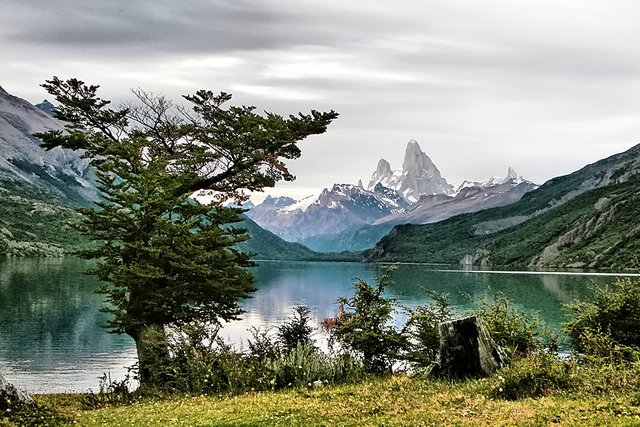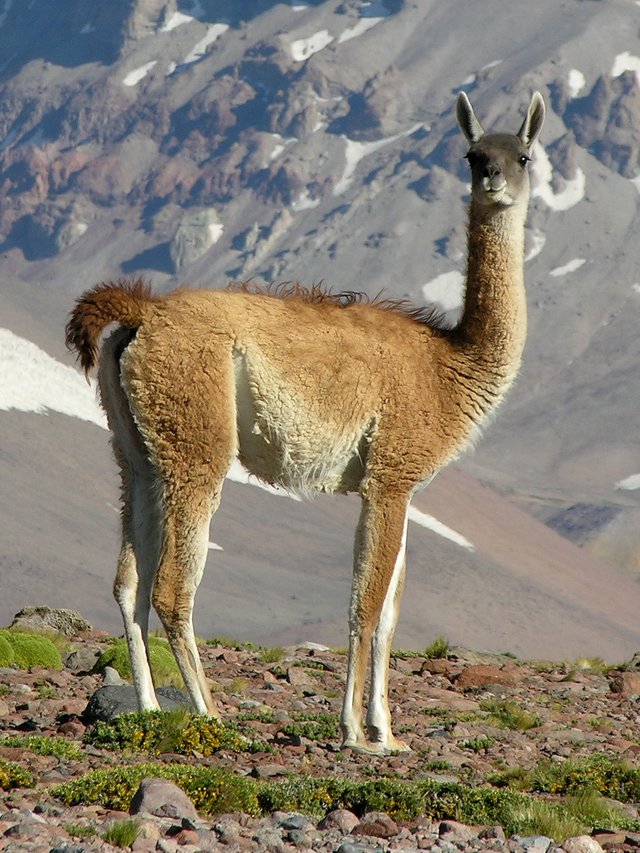Chile has officially created 5 new national parks and expanded three previous ones in a move that protects over 10 million acres of land!
When we want to protect certain ecosystem, species or just protect nature in general, creating a legal protection is very important, so I am a huge fan of making national parks and other areas where there are strict restrictions as to what you are allowed to do within the area. Not only does this give a signal that the government care for the nature in this area, but it also increases their ability to control it, and potentially remove illegal activities from it if it is needed.

A Patagonian landscape. Areas like this one is now protected on the Chilean side of the Patagonia! Image by Wikimedia Commons users Adroar, posted with the Creative Commons Attribution-Share Alike 3.0 Unported license.
Just a few days ago the Chilean government announced that they had created several national parks in regions with unique features, which is a huge win for conservationists who want us to take better care of the nature around us. It was only made possible because of a private conservation group that has been buying lands and cooperated with the government, which goes to show that even non-governmental organizations can make a big change in the world.
10 million acres of new national parks in Chile
Tompkins Conservation is a conservation group owned by Doug Tompkins and Kristine McDivitt Tompkins, and they are what made this possible. During the last 25 years this couple has been buying lands in Chile in order to protect it, and after much hard work their efforts paid off. On Monday (January 29) Tompkins Conservation donated a total of 1 million acres of their land to the Chilean government. In additions to this, the government themselves had purchased another 9 million acres of land, giving them a total of 10 million fit for new protection!
This donation is the largest donation of land from a private company to the government ever donated, but as Kristine Tompkins said during the donation, it has not been easy. You can imagine how the local felt when two Americans came to South America to buy lands in order to prevent the locals from using it for grazing, farming and living. My professes always used to say that the most useful skill for a conservation biologist is the ability to negotiate and get people to agree, which is not far from the truth at all.
However, after 25 years of hard work it all paid off, and Chile now has five new national parks, as well as having expanded three of their older parks!
Perito Moreno Glacier in Patagonia (note that it is on the Argentinan parts of Pategonia). Image by I, Luca Galuzzi, posted with the Creative Commons Attribution-Share Alike 2.5 Generic license.
The protected lands are in a region called the Patagonia, an area at the south base of the Andes mountains that is shared by Chile and Argentina. This region has a lot of interesting animal and plant life, as well as unique geological features, so it’s worth conserving! Some cool animals that you can find in this regions is the Chilean flamingo (Phoenicopterus chilensis), the guanaco (Lama guanicoe), the Patagonian fox (Lycalopex griseus) and the Patagonian hog-nosed skunk (Conepatus humboldtii), but there are also many more! A better list can be found on this Wikipedia page that lists a lot of the animal species in this region.

A guanaco; the non-domesticated version of llama is found in this region! Image by Flickr user xxxx, posted with the Creative Commons Attribution-Share Alike 2.0 Generic license.
How much exactly is 10 million acres?
The total area of the new national parks and the three expanded parks is even bigger than the entire country Switzerland, which is far from the biggest country in the world, but it still goes a long way to show how much nature we are actually talking about. 10 million acres is roughly 40,468 square kilometers, while the total area of Switzerland is just a little bit higher with its 41,285 km²!
This short YouTube video is from the donation ceremony, but also shows a breathtaking view of some of the areas that have now been protected!
By the way, this is not the first time Chile has spent a lot of money on protecting animals and nature! If you click on that link you can see that the Chilean government preferred to save the breeding grounds of Humboldt Penguins (Spheniscus humboldti) instead of being able to mine 12 million tonnes of iron and 150,000 tonnes of copper, which is worth a lot of money.
National parks are not perfect
It’s important to keep in mind that national parks are far from perfect, but they are still one of the most important tools the conservation biologists have. Even protected areas do often get affected by logging or illegal hunting – which shows that the government needs to also provide money for someone to physically protect the areas as well. While this is a bigger issue in some countries than others, I do assume that Chile are pretty good at protecting their protected areas since they have shown themselves to be a leading country for conservation biology, but I’ll be honest and say that I’m not that familiar with Chile as a country, so it’s difficult for me to draw any conclusions about this.
National parks are not all that restricted, and visitors will be able to visit the parks. However, there are big limitations to how the areas can be used in terms of farming, grazing, building and logging, so any use of the land must not be exploited.
Thanks for reading
Thanks for reading about the huge national parks that has just been created in Chile. I believe this is very good news for the species and ecosystems found in this place, and hopefully more governments will follow their footsteps and protect their own ecosystems. If you want to read more, then check out the press release by Tompkins Conservation – because nothing beats the original source. However, you can also read more about it on National Geographic, The Guardian, or probably any other major news outlet. Anyway, I hope you enjoyed reading the good news!
this is interesting to me for good and bad reasons: the first is that it
looks like they are creating a 17-park contiguous land corridor, which
drastically increases the positive ecological impact of any given area.
but second i'm concerned that they mean to over-rest the land and
restrict appropriate grazing. Allan Savory worked with Patagonian ranchers to reverse
desertification I hope land managers will (continue to) apply holistic
management to the conservation effort, otherwise the over-rest will
result in further ecological deterioration, not "protection.
Thanks for leaving a good comment, @kouba01! I was not aware of the issues with desertification in the Patagonia. But you are absolutely right; I hope they also have this in mind when taking care of the national park. Chile has so far seemed like a country that is taking its conservation efforts seriously, so I would expect them to have a long-term plan for the national parks that also includes these problems.
Chile has highest per capacita income in latin america and the govt are doing great job for the people and conservation of biologist with the collaboration of Doug Tompkins and Kristine McDivitt Tompkins.
Yes it is a great skill to negotiate people and get them agree to your goal. The process become much easier if you have good economy, high per capacita income and quality life of people.
Developing national park of 10 million acre and 25 years of hardwork by the govt efforts are laudable. Other countries should also follow the chilean govt in this regard. In this way we conserve a lot of species.
Yeah, absolutely! I would imagine that it is extremely difficult to get people to stop using an area for food gathering or farming if they did rely on that food in order to survive.
Just imagine how many species and ecosystems that would be protected if every country tried as much as Chile did! The world would certainly be a better place for most animals :)
Yes it is a great idea, but I am afraid to say all countries don't adopt it due to dense human population, food for human etc. Although I am in favor of developing places for wild life to balance eco
Yeah, it's a very unrealistic dream ;)
This is awesome news for Chili. The pictures of the parks here look so beautiful, I hope to one day be able to checlkthem oit in person. Im happy to see that the chilian government is interested in protecting these different species/ecosystems!
Yeah, it is a really beautiful place, @justfordogz! I hope they are able to make the parks even bigger in the future, because I want more people to be able to experience places like this.
You received a 10.0% upvote since you are not yet a member of geopolis.
To read more about us and what we do, click here.
https://steemit.com/geopolis/@geopolis/geopolis-the-community-for-global-sciences-update-3
If you do not want us to upvote and comment on your posts concerning earth and earth sciences, please reply stop to this comment and we will no longer bother you with our love ❤️
Thank you :D
this is a bold move and a good one by the chilean government, as most countries are destroying natural habitats , the chileans are safe guarding for the next generation
Yeah, it's really a great move by the Chilean government!
What a great new! I'm happy for Chilean people. Thanks for the post.
Me too :) I hope these areas will spread all around the world day by day!
I'm really happy for them too! And you're welcome :)
that's great news for the species, protecting animals and nature by this Chile step. Right! hard work and always good efforts paid off. Also should take actiOn by Government, because this is responsible for this work!
This a great man Chile :)
Yep, this is indeed great news for the animal species that live in this region! I hope more countries follow Chile's footsteps :D
wawoow thats really agreat step taken by chile to protect 10 million i mean thats a hugh amount really appericated!
Yeah, 10 million acres is a whole lot!
yap it is if that has been cultivated that will be a great achivement!
Its good for me that you love nature i also love this and for enjoying this i travel in different countries
Traveling around the world and experience the nature all over must be very nice!
Truly great news.
We need to take care of the world. Private companies will not do this. governments need to take action!
I agree that the governments need to take responsibility for this, but it is always nice to get help from private organizations such as the one who helped create these huge national parks in Chile.